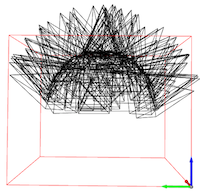Direct Voxel Grid Optimization (CVPR2022 Oral, project page, DVGO paper, DVGO v2 paper).
github_teaser_inward_bounded.mp4
github_teaser_forward_facing.mp4
A short guide to capture custom forward-facing scenes and rendering fly-through videos.
Below are two rgb and depth fly-through videos from custom captured scenes.
casual_capturing.mp4
- Speedup NeRF by replacing the MLP with the voxel grid.
- Simple scene representation:
- Volume densities: dense voxel grid (3D).
- View-dependent colors: dense feature grid (4D) + shallow MLP.
- Pytorch cuda extention built just-in-time for another 2--3x speedup.
- O(N) realization for the distortion loss proposed by mip-nerf 360.
- The loss improves our training time and quality.
- We have released a self-contained pytorch package: torch_efficient_distloss.
- Consider a batch of 8192 rays X 256 points.
- GPU memory consumption: 6192MB => 96MB.
- Run times for 100 iters: 20 sec => 0.2sec.
- Supported datasets:
- Bounded inward-facing: NeRF, NSVF, BlendedMVS, T&T (masked), DeepVoxels.
- Unbounded inward-facing: T&T, LF, mip-NeRF360.
- Foward-facing: LLFF.
git clone git@github.com:sunset1995/DirectVoxGO.git
cd DirectVoxGO
pip install -r requirements.txt
Pytorch and torch_scatter installation is machine dependent, please install the correct version for your machine.
Dependencies (click to expand)
PyTorch,numpy,torch_scatter: main computation.scipy,lpips: SSIM and LPIPS evaluation.tqdm: progress bar.mmcv: config system.opencv-python: image processing.imageio,imageio-ffmpeg: images and videos I/O.Ninja: to build the newly implemented torch extention just-in-time.einops: torch tensor shaping with pretty api.torch_efficient_distloss: O(N) realization for the distortion loss.
(click to expand;)
data
├── nerf_synthetic # Link: https://drive.google.com/drive/folders/128yBriW1IG_3NJ5Rp7APSTZsJqdJdfc1
│ └── [chair|drums|ficus|hotdog|lego|materials|mic|ship]
│ ├── [train|val|test]
│ │ └── r_*.png
│ └── transforms_[train|val|test].json
│
├── Synthetic_NSVF # Link: https://dl.fbaipublicfiles.com/nsvf/dataset/Synthetic_NSVF.zip
│ └── [Bike|Lifestyle|Palace|Robot|Spaceship|Steamtrain|Toad|Wineholder]
│ ├── intrinsics.txt
│ ├── rgb
│ │ └── [0_train|1_val|2_test]_*.png
│ └── pose
│ └── [0_train|1_val|2_test]_*.txt
│
├── BlendedMVS # Link: https://dl.fbaipublicfiles.com/nsvf/dataset/BlendedMVS.zip
│ └── [Character|Fountain|Jade|Statues]
│ ├── intrinsics.txt
│ ├── rgb
│ │ └── [0|1|2]_*.png
│ └── pose
│ └── [0|1|2]_*.txt
│
├── TanksAndTemple # Link: https://dl.fbaipublicfiles.com/nsvf/dataset/TanksAndTemple.zip
│ └── [Barn|Caterpillar|Family|Ignatius|Truck]
│ ├── intrinsics.txt
│ ├── rgb
│ │ └── [0|1|2]_*.png
│ └── pose
│ └── [0|1|2]_*.txt
│
├── deepvoxels # Link: https://drive.google.com/drive/folders/1ScsRlnzy9Bd_n-xw83SP-0t548v63mPH
│ └── [train|validation|test]
│ └── [armchair|cube|greek|vase]
│ ├── intrinsics.txt
│ ├── rgb/*.png
│ └── pose/*.txt
│
├── nerf_llff_data # Link: https://drive.google.com/drive/folders/128yBriW1IG_3NJ5Rp7APSTZsJqdJdfc1
│ └── [fern|flower|fortress|horns|leaves|orchids|room|trex]
│
├── tanks_and_temples # Link: https://drive.google.com/file/d/11KRfN91W1AxAW6lOFs4EeYDbeoQZCi87/view?usp=sharing
│ └── [tat_intermediate_M60|tat_intermediate_Playground|tat_intermediate_Train|tat_training_Truck]
│ └── [train|test]
│ ├── intrinsics/*txt
│ ├── pose/*txt
│ └── rgb/*jpg
│
├── lf_data # Link: https://drive.google.com/file/d/1gsjDjkbTh4GAR9fFqlIDZ__qR9NYTURQ/view?usp=sharing
│ └── [africa|basket|ship|statue|torch]
│ └── [train|test]
│ ├── intrinsics/*txt
│ ├── pose/*txt
│ └── rgb/*jpg
│
├── 360_v2 # Link: https://jonbarron.info/mipnerf360/
│ └── [bicycle|bonsai|counter|garden|kitchen|room|stump]
│ ├── poses_bounds.npy
│ └── [images_2|images_4]
│
├── nerf_llff_data # Link: https://drive.google.com/drive/folders/14boI-o5hGO9srnWaaogTU5_ji7wkX2S7
│ └── [fern|flower|fortress|horns|leaves|orchids|room|trex]
│ ├── poses_bounds.npy
│ └── [images_2|images_4]
│
└── co3d # Link: https://github.com/facebookresearch/co3d
└── [donut|teddybear|umbrella|...]
├── frame_annotations.jgz
├── set_lists.json
└── [129_14950_29917|189_20376_35616|...]
├── images
│ └── frame*.jpg
└── masks
└── frame*.png
-
Training
$ python run.py --config configs/nerf/lego.py --render_test
Use
--i_printand--i_weightsto change the log interval. -
Evaluation To only evaluate the testset
PSNR,SSIM, andLPIPSof the trainedlegowithout re-training, run:$ python run.py --config configs/nerf/lego.py --render_only --render_test \ --eval_ssim --eval_lpips_vggUse
--eval_lpips_alexto evaluate LPIPS with pre-trained Alex net instead of VGG net. -
Render video
$ python run.py --config configs/nerf/lego.py --render_only --render_video
Use
--render_video_factor 4for a fast preview. -
Reproduction: all config files to reproduce our results.
(click to expand)
$ ls configs/* configs/blendedmvs: Character.py Fountain.py Jade.py Statues.py configs/nerf: chair.py drums.py ficus.py hotdog.py lego.py materials.py mic.py ship.py configs/nsvf: Bike.py Lifestyle.py Palace.py Robot.py Spaceship.py Steamtrain.py Toad.py Wineholder.py configs/tankstemple: Barn.py Caterpillar.py Family.py Ignatius.py Truck.py configs/deepvoxels: armchair.py cube.py greek.py vase.py configs/tankstemple_unbounded: M60.py Playground.py Train.py Truck.py configs/lf: africa.py basket.py ship.py statue.py torch.py configs/nerf_unbounded: bicycle.py bonsai.py counter.py garden.py kitchen.py room.py stump.py configs/llff: fern.py flower.py fortress.py horns.py leaves.py orchids.py room.py trex.py
Coming soon hopefully.
Adjusting the data related config fields to fit your camera coordinate system is recommend before implementing a new one. We provide two visualization tools for debugging.
- Inspect the camera and the allocated BBox.
- Export via
--export_bbox_and_cams_only {filename}.npz:python run.py --config configs/nerf/mic.py --export_bbox_and_cams_only cam_mic.npz
- Visualize the result:
python tools/vis_train.py cam_mic.npz
- Export via
- Inspect the learned geometry after coarse optimization.
- Export via
--export_coarse_only {filename}.npz(assumedcoarse_last.taravailable in the train log):python run.py --config configs/nerf/mic.py --export_coarse_only coarse_mic.npz
- Visualize the result:
python tools/vis_volume.py coarse_mic.npz 0.001 --cam cam_mic.npz
- Export via
| Inspecting the cameras & BBox | Inspecting the learned coarse volume |
|---|---|
 |
 |
We have reported some ablation experiments in our paper supplementary material.
Setting N_iters, N_rand, num_voxels, rgbnet_depth, rgbnet_width to larger values or setting stepsize to smaller values typically leads to better quality but need more computation.
The weight_distortion affects the training speed and quality as well.
Only stepsize is tunable in testing phase, while all the other fields should remain the same as training.
- Octree — Plenoxels: Radiance Fields without Neural Networks.
- Hash — Instant Neural Graphics Primitives with a Multiresolution Hash Encoding.
- Factorized components — TensoRF: Tensorial Radiance Fields.
You will need them for scaling to a higher grid resolution. But we believe our simplest dense grid could still be your good starting point if you have other challenging problems to deal with.
The code base is origined from an awesome nerf-pytorch implementation, but it becomes very different from the code base now.